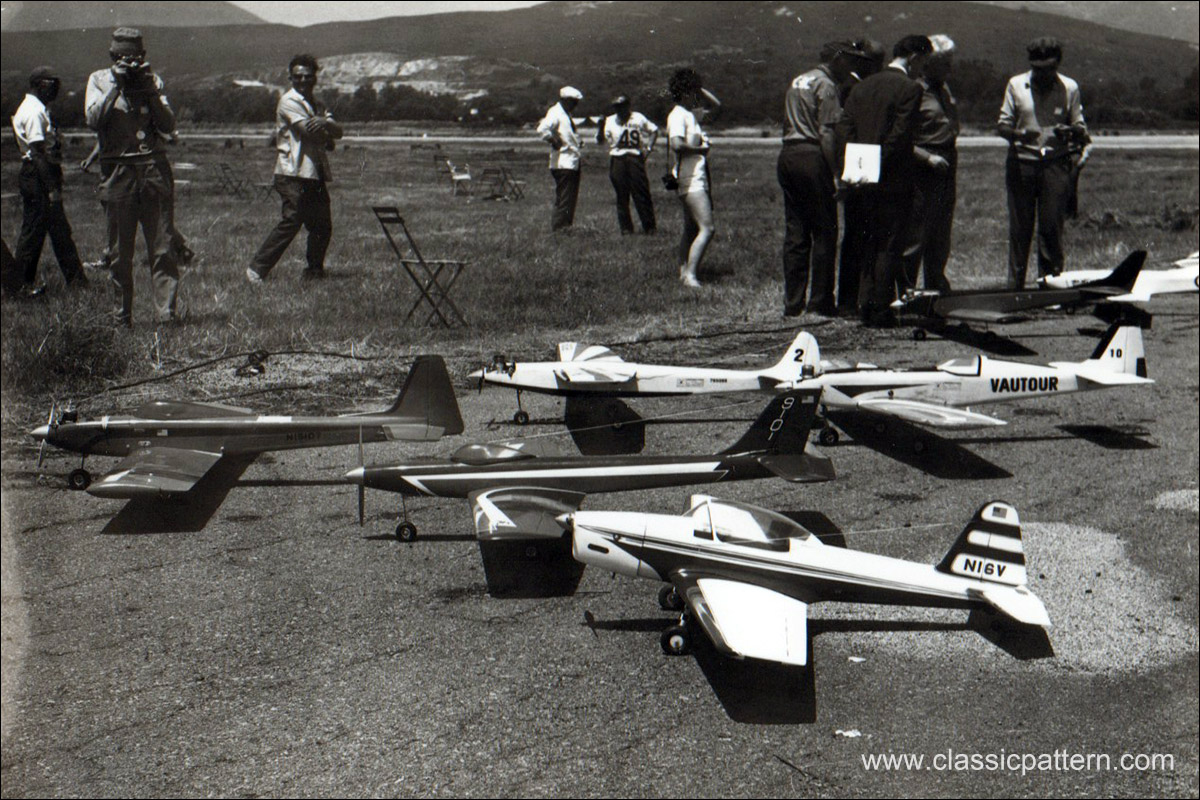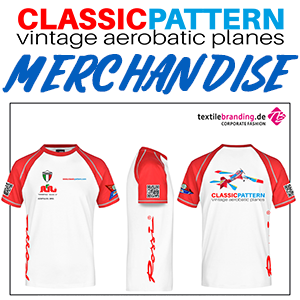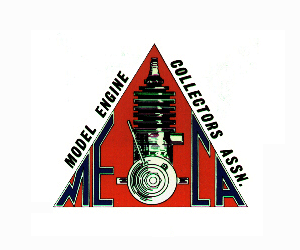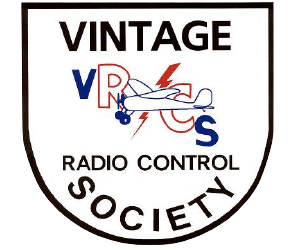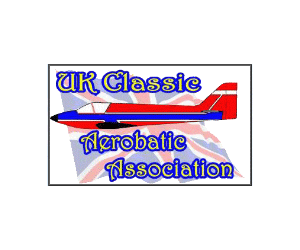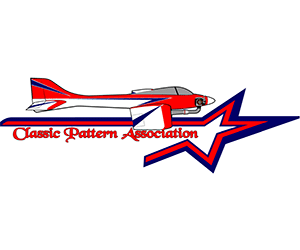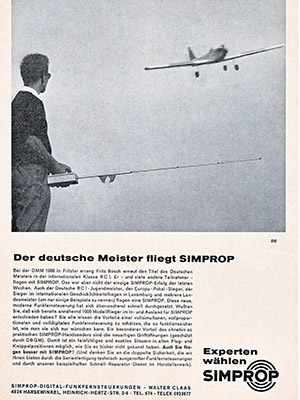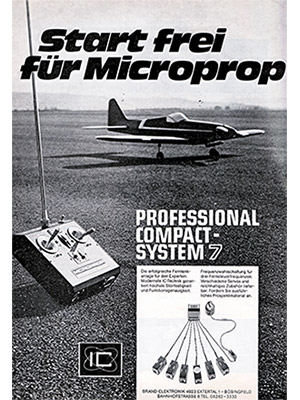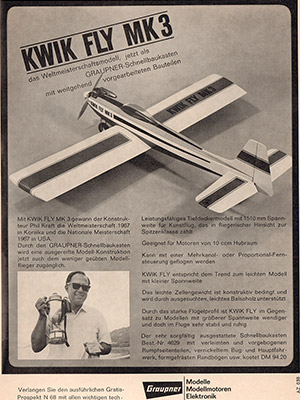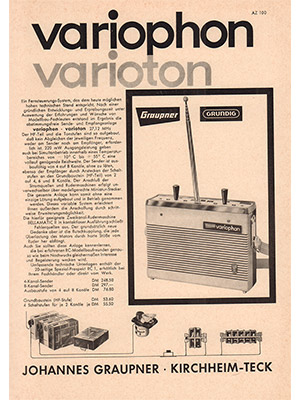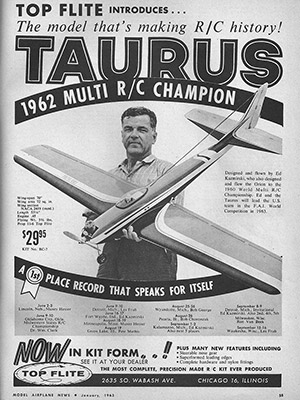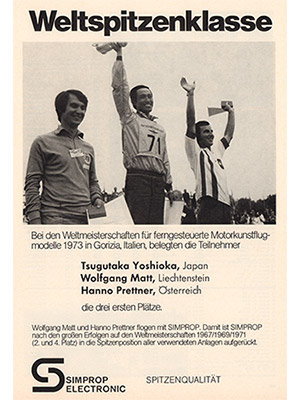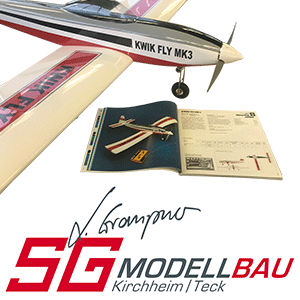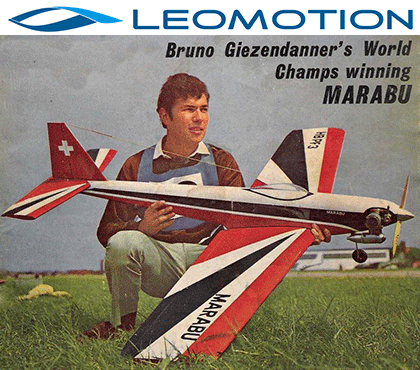In our series of past RC1 (F3A) World Championships, our aim is to document as accurately as possible all the World Championships that have ever taken place over the last 50 years. Old reports, supplemented by photos collected worldwide from contemporary witnesses, are preserved for posterity by Classicpattern. Our grandfathers were ingenious pilots and inventors who achieved impressive things with the still underdeveloped technology of the time.
The 5th World R/C Championships was held 21st-25th June, at Ajaccio, Corsica, organized by the Federation Francaise d’Aero Modelism. Meeting point for competitors and official parties was at Nice on the 21st from where we were to be flown across to the Mediterranean island.
Taking in a little of Nice that morning, we espied old faces in a street cafe, Jesper von Segebaden, Ulf Tonnesen and Poju Stephansen, together with other members of the Swedish and Norwegian teams and it seen became filled R/C type people, including the entire British contingent and the U.S. team.

After drinks at a reception given by the Mayor of Nice (there had been an invitation awaiting us at Nice Airport when we arrived by Caravelle, 2 a.m. that morning) wen went by coach back to Nice airport for transport to Ajaccio, with two irrepressible Americans hanging from the window taking countless Photographs of “objects of interest” along the route . . it must be a dull life in California!
So, across to Ajaccio in an Air France Deux Ponts, a four piston engined, twin fin monster with so much fus side area it looked as though it might be great for knife edging ! On the way, the pilot followed the Corsican coast line, treating us to the beauty of this wild and rocky island, where, up in the mountains, the bandits have left their mark on the sign posts riddled with bullet holes!

On arrival, there was immediate cause for concern among the British Team. Both Dennis Hammant’s models had sustained tail cone damage on route from Nice and some bright spark had even managed to stub his cigarette on the spare “Spectre”, burning right through the styro “glove” to leave a neat round char mark on the underside skin. Chris Olsen’s number one Model has also sustained a chip on the elevator.
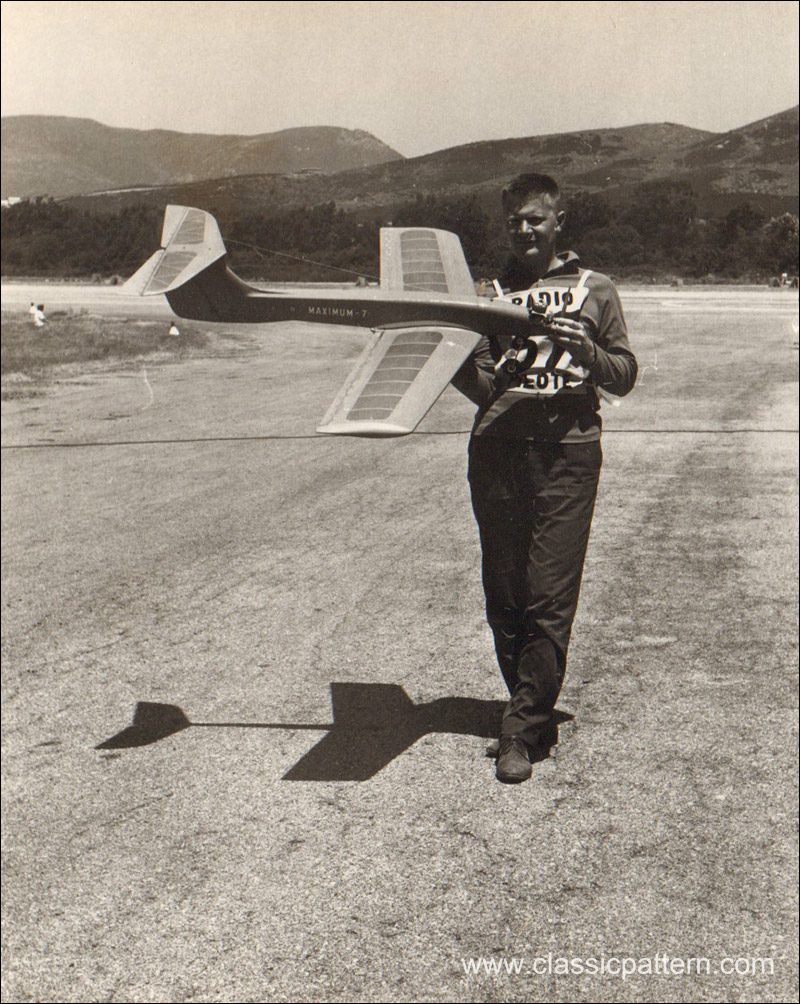
After this disquieting episode, we were driven across the bay to Marina Viva, the holiday camp type establishment on the edge of the sea, where we were billeted in small chalets, the veritable house of singing bamboo at night, if not due to Unc1e Sam’s lads next door, then by the bugs in the bamboo ceiling.
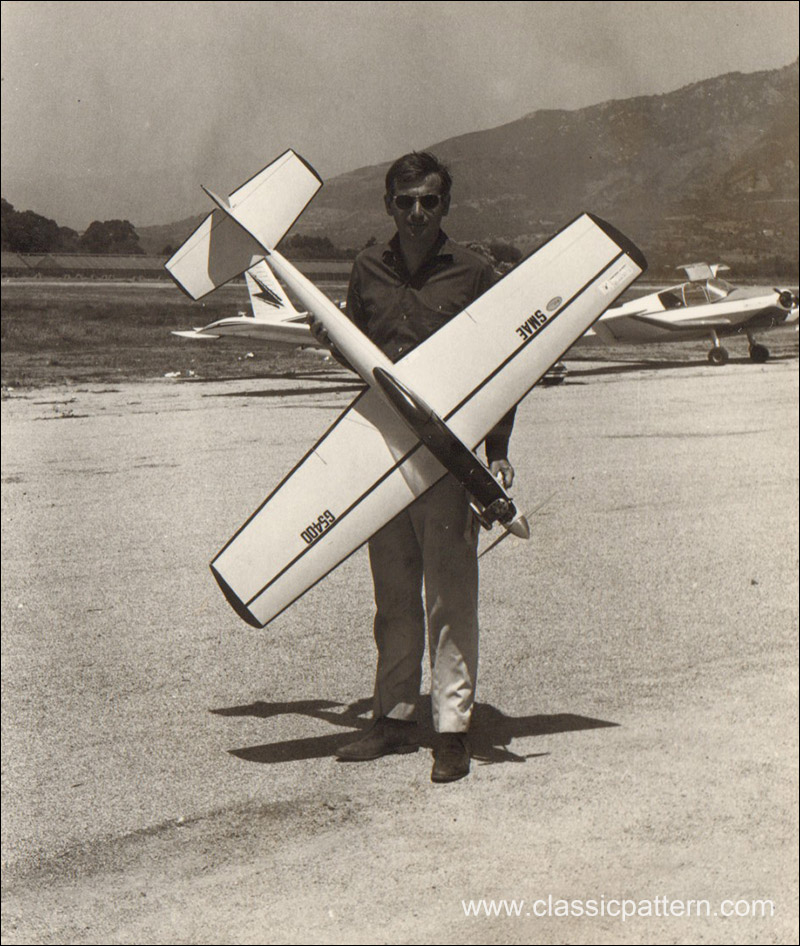
Practice day, 22nd, was taking stock day as we moved around the hangar perusing models and modelers involved in the championships. 17 nations in all were represented, including teams from Greece, Liechtenstein and Luxembourg entering for the first time.

Chris Olsen had two examples of his Upset, which had shown well at the previous championships in Sweden, while Peter Waters also had two identical models, not the Thunderstormer type that he had used at the team trials, but definitely displaying Thunderstormer influence even if they were larger and with leading edge taper, sporting slender fuselage and big fin and rudder assembly. Dennis Hammant was pinning his hopes on his big 7ft. King Spectre, backed up by the Spectre as a reserve.
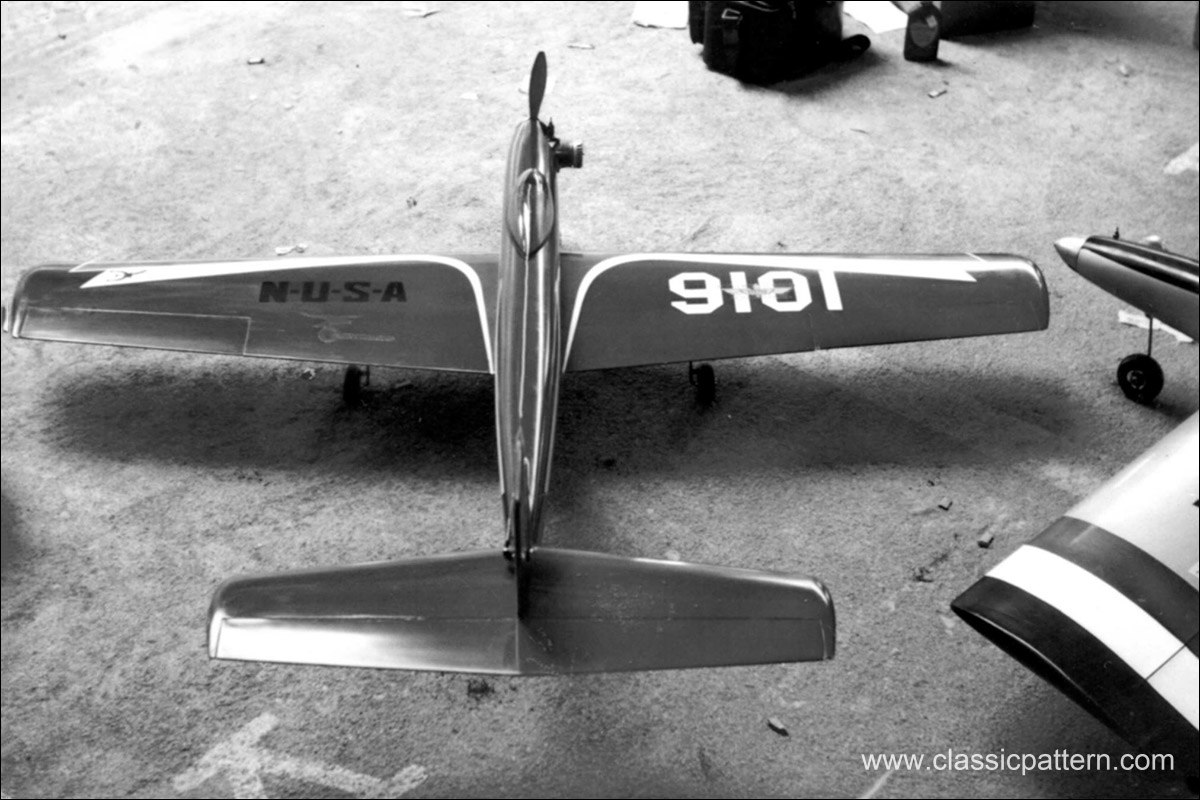
The South Africans were an interesting group, each with two well prepared, identical models. Chris Sweatman had a low winger with inverted motor called Condor, Johnny Wessels had two red, white and blue Kwik-Fli II and Rich Brand displayed two beautifully prepared originals based on the Northrop F-5A Freedom Fighter. We would add here that Rich is a Rhodesian Air Force Hunter pilot.

Of the U.S.A. team, Phil Kraft has a Kwik-Fli with re-arranged tail cone called Kwik-Fli III, Cliff Weirick, produced two identical models of Hal Krier’s modified Chipmunk, and Doug Spreng produced a new model, the Twister, only 54 ins. span, with 574 sq. in. area.

The French, Marrot and Cousson had shoulder wing machines designed by Marrot, and Pham a low wing original. Other notable models were the Maximum-7 low wing design by Stephansen of Norway and used also by team mate Rapstad. This was a small machine, very light, with swept wing and swept tee tail assembly.
Also of interest was the fact that Fritz Bosch’s Super Delphin design was apparently finding some favour, used by Matt of Liechtenstein, Schenk and Gloor of Switzerland as well as Fritz himself. One of the Swiss models incidentally, was so heavy that at processing time, the silencer had to be removed to bring it within the 11.023 lbs. limit.
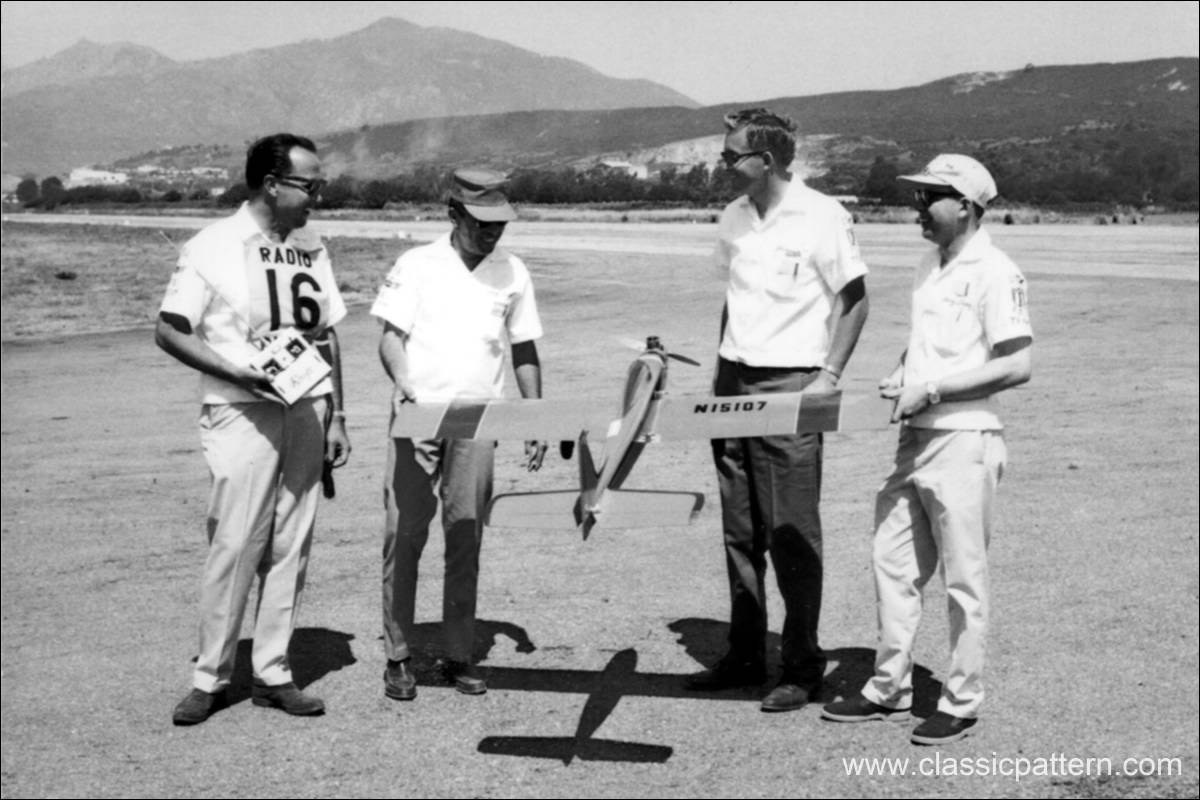
Practice time for the British team came during midafternoon and Olsen, Waters and Hammant took their number one machines out to the tarmac in the company of team manager Geoff Franklin to make the best use of their 45 mins. allotted time. Almost immediately, the gremlins struck again when Peter Waters’ Thunderball crashed, apparently due to aileron flutter. It turned out that the aileron servo had in fact come Loose inside the wing, consequently contributing to another in a series of unhappy incidents that dogged the British team throughout the championships.

The British were followed by the Italians, of whom Reda was the only flier in the entire championships flying a kit design, the Italian Aviomodelli I-Laser. Another Italian team member, Guglleminetli is, incidentally, an Italian motor racing champion.
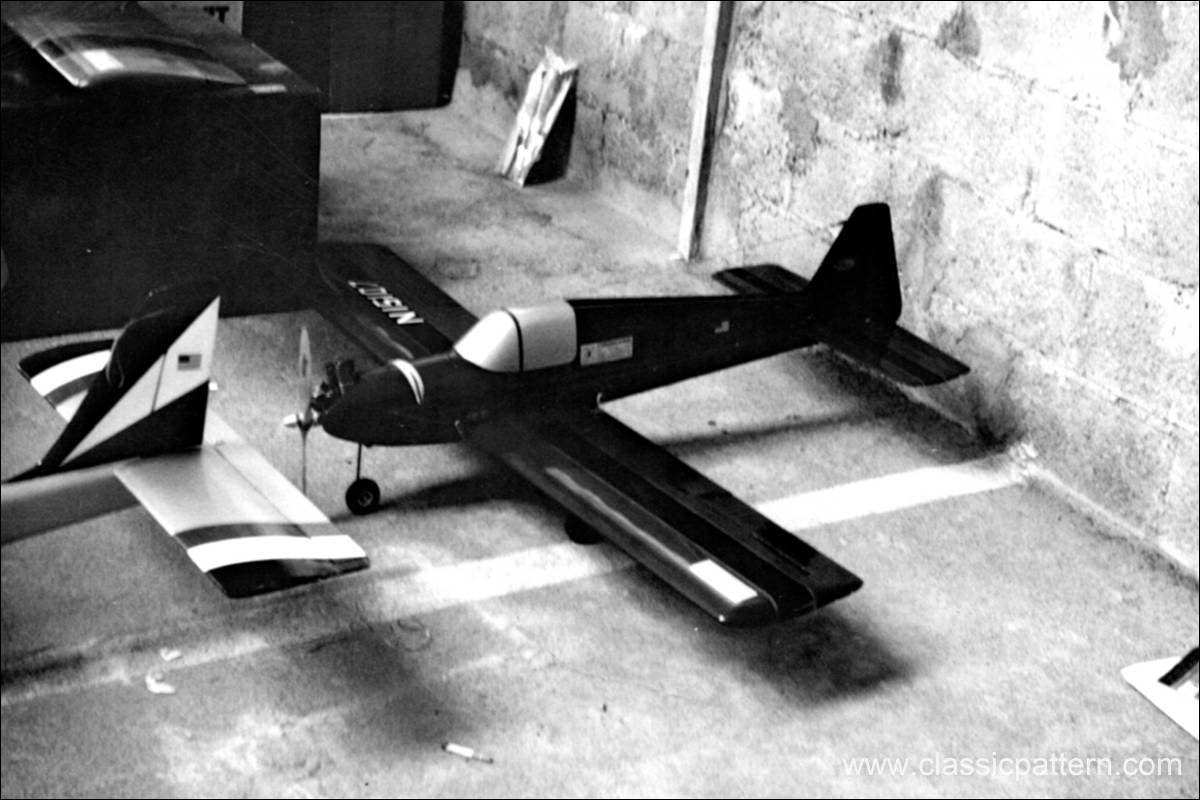
After the Italians came the Americans, among whom Kraft was watched with greatest interest. Weirick’s Chipmunk appeared to drop a wing slightly during each looping manoeuvre, suggesting perhaps an out of balance wing.
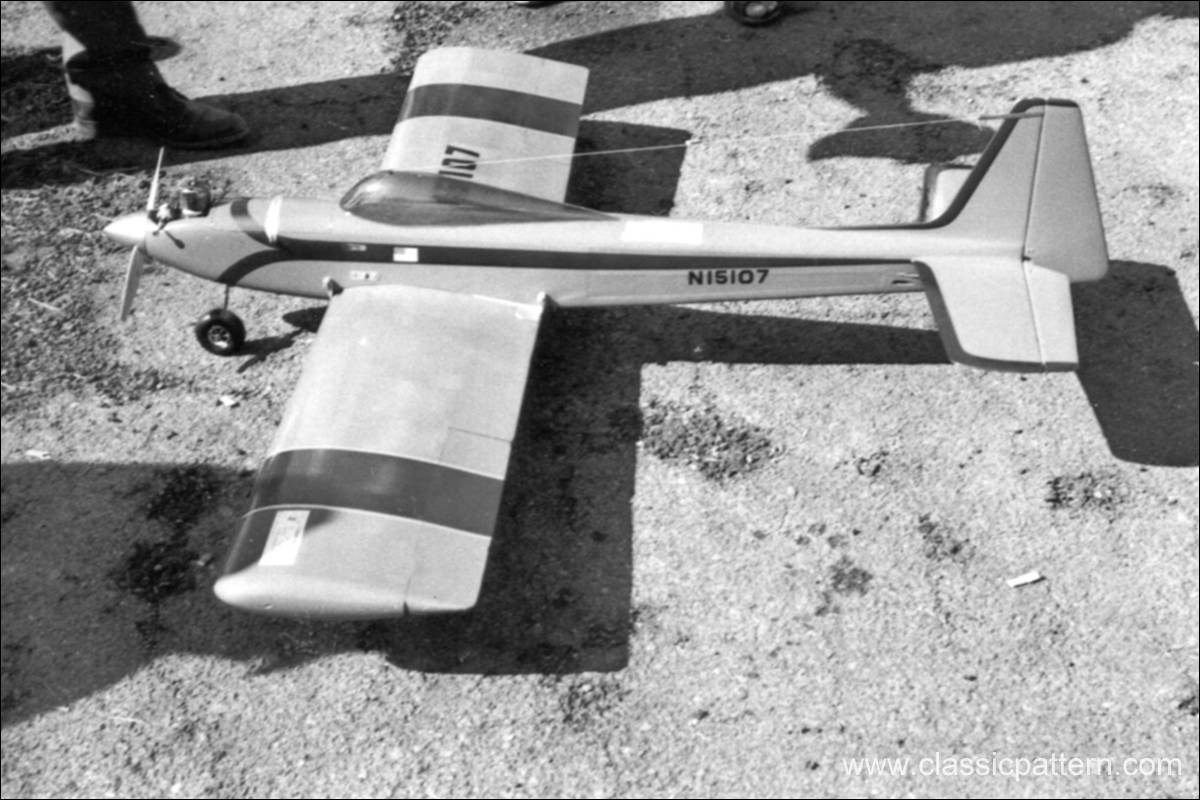
Round 1
Flying was intended to start at the shocking hour of 6 a.m., and follow through to 8 p.m.—a gruesome thought for judges.

It fell to Ulf Tonnessen of Norway to open the competition with the first flight, using the Propoflex proportional system which he built himself. Following Ulf was Fritz Bosch for Germany who landed after 8 minutes claiming interference which was cycling the throttle of his Super Delphin and triggering the rudder. We not so early birds heard about it at breakfast, and considering that we were living 3-4 miles from the airfield, the grapevine was good.

Though some squawked about contest tactics, it became painfully clear as the morning wore on that there was a worrying amount of “garbage” in the 27 Mc/s R/C waveband. Fortunately, it could be monitored, thanks to the availability of the very fine monitor being used by the Simprop people in support, first of all, of Fritz Bosch and Walter Schmitz.

Peter Waters was the first to fly for Great Britain, pushing his now only remaining model through the schedule to acrue 4,049 points, the highest so far. This distinction did not last long however, since the next man up was U.S.A.’s Doug Spreng, whose 54 in. span slender fuselage Twister zipped through the pattern as Doug manipulated the one-stick transmitter. Unlike some of the “unofficial” reporters whose opinions have already appeared in newsletter print, we admired this flight, which gathered 4,736 points for the U.S. team.

Scores now began to climb. 19 year old Matt of Liechtenstein, a completely unknown quantity performing steadily to total 4,430.
When Chris Olsen came out to fly, the interference persisted on 26.995 Mc/s (brown), and Chris called an attempt in order to change frequencies.

Immediately after Olsen, came Cliff Weirick for U.S.A. with his near scale D.H. Chipmunk, a model that attracted a great deal of interest because it was a scale model competing on equal terms with typical competition multi models. Using electric main wheel brakes and steerable tailwheel, the Chipmunk taxied out and swung into wind to make its take-off run from a compulsory standing start, with the Veco 61 partially throttled to prevent the power from pulling the small, tailwheel machine over onto its nose. Immediately the pretty machine broke ground, the motor audibly “opened up” to full power.

The little model really tore up the sky through large loops and eights, but we could not help but notice that in these manoeuvres one wing tip would consistently drop. Nevertheless, it was a performance good enough for 4,253 points.
Next up was Chris Sweatman for South Africa, and what a pleasure to watch all three of these South African boys—a real example of team effort. Chris used his Logictrol radio to slip the swept wing Condor through its paces and raked in 4,616 points which he well deserved.

By now we were beginning to appreciate the bar, over which many Francs were to pass as we drank to keep ourselves going. Fair skinned types did their best to protect their limbs from the sun, and someone did a roaring trade in sun hats!
Third man up for Great Britain was Dennis Hammant flying his 7ft. span King Spectre. After completing the double stall turn, the model lifted into the combined immelman, rolled across the top and dipped into the half outside loop reversal. It was sickening to watch because from about halfway down, it was quite obvious that the big beast was not going to make it, finally meeting the ground in a virtually horizontal attitude. Another set back for the British team.

Post crash inspection tended to suggest a loose elevator horn.
Immediately after this came Phil Kraft, third member of U.S.A.’s team, a flight watched with considerable interest. Phil slipped the light Kwik-Fli III through the schedule with seemingly effortless ease to gain the staggering total of 5,317 points.

After Kraft came Rich Brand for South Africa, using Logictrol radio like team mate Sweatman. Again it was a good performance, which netted 4,677 points to put the South African team in a strong position.
At the end of round one then, Kraft led followed by Kurt Bauerheim of Germany, who had quietly worked himself into second place with a 4,825 points flight which we unfortunately missed. Third was team mate Schmitz, followed closely by Doug Spreng, U.S.A. Behind Spreng was Marrot of France, then Brand and Sweatman in sixth and seventh places followed by another surprise, Matt of Liechtenstein.

For the British team, Chris Olsen held eleventh place, Waters was number fifteen, while Hammant languished one from the bottom at number fortyone, just below Fritz Bosch, who, having been allowed a second attempt for his interference troubles early in the day managed 810 points thanks to a very bad motor run. We bet he wished he had settled for that first, interference affected flight.

For Hammant, it meant quick interchanging of equipment, and a duck test flight to trim out his smaller Spectre for the following day’s flight. Collectively, the U.S.A. team held top team place, followed by the South Africans and the French team of Marrot, Cousson and Pham.

Round 2
Round two started an hour later than the previous day’s opened by Reineri of Italy.

Bauerheim for Germany, was ninth man in the air, using German Multiplex 101 radio. It was a good performance, but not quite so good as his previous Right, gaining only 4,710 points.
First up for Britain was Dennis Hammant, obviously still feeling the effect of his first round wipe out. It was a shaky flight, and he nearly copped it again, when a low entry to the top hat resulted in an even lower, abrupt exit.
The 3,344 point total was somewhat lower than we would have awarded.

In his wake came Phil Kraft with a magnificently precise Performance, including the best “by the book” tail slide we have seen yet—not just a hammer head stall, but three fuselage lengths slide before flipping forward to recover. It gained Phil 5,663 points—the ton scoring flight of the entire championships.
All went well for Richard Brand, but by the time he reached the Top Hat, his motor sounded a little sick. It cut during the sein. but there was still enough height left for the U.D.I. Panzer to make a square approach before landing. Nevertheless, Rich lost points this round totaling 4,043.

Marrot of France, manufacturer of Radio Pilote proportional equipment flew his shoulder wing Satanas to gain 5,514 points which was a surprise for us, since we noticed some bad superimposition and intersections in the loops and eights.
Early in the afternoon, Fritz Bosch showed what might have been with a cracking flight which netted 5,194 points. Fritz’s Super Delphin design, with Simprop proportional radio is certainly a smooth performer.

Second man up for Great Britain was Peter Waters, fighting aileron trim trouble and unsettled motor for only 3,358 points. a fair drop after his first round effort.
Waters was followed by Doug Spreng, whose small Twister missed the second half of the double stall turn, but went on to make a surprising 5,299 total, having lost a high coefficient manoeuvre.

For South Africa, Johnny Wessels flew Bonner Digimite equipped Kwik-Fli II, but although his team credited him as the best “home” performer among them, he was unable to make more than 4,202 on this flight.

Schmitz of Germany, whose model showed obvious Fritz Bosch Delphin influence, was another high point performer, gaining 5,187 points. Obviously, those pre-contest practice sessions on Corsica flown by the Simprop operators were paying off as far as Schmitz was concerned.
Last man out for Great Britain, third from last to fly was Chris Olsen, who put his Upset smoothly through its paces to produce a better performance than his 4,793 point total reflected-or so we thought.

At the end of round two therefore Phil Kraft of U.S.A. was holding onto his lead, and was now being chased by Marrot of France. Third now was Spreng, U.S.A., followed by Schmitz of Germany. Chris Sweatman’s fine flight lifted him into fifth position ahead of Kurt Bauerheim, now trailing to 6th place.

Matt of Liechtenstein moved up a place to seventh and with him went Chris Olsen in eighth position, showing that even if he had been flying proportional for only a few months, he had the mastery of it.

U.S.A. held onto their place at the head of the team table, followed by France who pushed the South Africans down to third place. The Germans lay fourth and the British team 9th, out of 17.

Round 3
Third round opener was Phil Kraft. whose Kwik-Fli III lifted a little past the vertical on the way up the first half of the double stall turn, but managed it nevertheless. His loops and bunts were all well superimposed, but he was one second slow on his roll. The tail slide was not as good as it had been the previous round.

The straight flight was also a bit bumpy-when you feed in correction, however minute in this manoeuvre, it is bound to show. Despite these points we picked up, one must remember that the better the Hier, and the bigger the reputation, the more hypercritical one becomes. As it was, the flight as a whole was worth 5,516 points.

Following Phil in the air was Rich Brand for South Africa, who showed off three nice loops and bunts. He was one second fast on his slow roll and a bit downhill too. He missed the tail slide but overall, performed well enough for a total of 4,817 points.

Marrot of France, did not net the high marks of his second flight, but still managed to get 5,044, for a flight which included a nice straight climb out from take-off. The model did not tail slide but performed a nice vertical eight, very straight inverted, and a well intersected overhead eight.

First Briton in the air was Peter Waters again, and just before taking his model out to the tarmac another of those depressing little incidents that dogged the British team occurred when the contents of Chris Olsen’s tool box spilled over the wing of Peter’s model.

His flight performance was typical Waters only in the impromptu bits, thrown in between scheduled manouevres, we have seen him perform so much better than this 3.871 point effort.

After Waters came Spreng for U.S.A., performing a very nice tail slide. The Americans were nominating their manoeuvres a little late, and Spreng’s mode] virtually was into the climb up for the tail slide before nomination came through. Despite three and a bit spins and an undulating landing approach, it was worth 4,826.

Olsen for Britain was really trying—perhaps a little too hard, for his slow roll was just a little barreling. Nevertheless, a good performance, gathering 4,628 points for the British team effort.
Last on the flight order was Dennis Hammant, who at last really got into his stride with some nice clean manoeuvres that gleaned a 4,244 point total.

Final totals then, made Phil Kraft World R/C Champion, while Pierre Marrot of France held on to second place. Kurt Bauerheim elevated himself into third position by virtue of a really fine third round performance.
Final fourth placer was Doug Spreng, U.S.A., followed by Schmitz of Germany and Matt of Liechtenstein. Top South African was Chris Sweatman in seventh place, just ahead of Giezendanner, another entrant whose third round performance considerably improved his final placing.

Top Briton was Chris Olsen in 9th position, while Peter Waters took 23rd place, and Dennis Hammant 32nd.

Final team placings gave the U.S.A. the overall lead, so that once again the individual and team trophies go across the Atlantic. Second highest team was Germany, followed by those hard working South Africans, while the French team slipped to fourth place. In fifth place were the Swiss team, and the British lads came up to 6th place thanks to some all round good flying in the last round.

In all, it was a contest not without its unhappy side, the worst incident occurring when models were marshalled on the tarmac during the third round, for mass and individual photography with competitors.

It was a good idea on the part of the French organizers but ruined by the Gendarmes left in charge of proceedings, who refused per-mission to all but team managers to enter the compound—not even team members. It seems impossible to get through to them that one cannot take photographs without photographers. Eventually the British models were removed from the compound in protest, to the applause of many.

The same kind of strong arm police tactics occurred again at the prize giving ceremony preceded by seemingly endless speeches which few understood, and in which even fewer were interested, where the only object seemed to be to prevent photographers from doing their job.

Trends
What trends in models and equipment did this championship reflect? Well, to begin with, reeds are now completely dead as far as world championship competition goes—not a single reed set used.

There appears to be a swing away from American radio control equipment, 26 competitors using European proportional gear, including Simprop (10), Radio Pilote (France) 4, Multiplex (Germany) 3, M.B.N. Logic Belle (Italy) 2, and one each Digi Fly (Swiss), Grundig, Micronic (Sweden), Vienna Prop (Austria), and Propollex (Norway).
There appear to be no radical trends in model design, although the move away from strip ailerons continues and most models have really large rudders, to be sure of that double stall turn.

Of the winner, we would say a really outstanding performance which always looked so effortless—but that is the mark of a champion, he always makes it look so easy.

For the British team, an unhappy championship, with compensation perhaps only in the knowledge that Britain is the only nation to have ever broken the American winning streck’ for top honours in both individual and team competition, with a team win in 1962.

There is also the interesting fact that Chris Olsen is the only international competitor to have competed in every World R/C Championships since the first in 1960.

Despite the bad taste of unsatisfactory “incidents” we must thank those involved in the central organization of the event for their efforts. To Robert Lestaournaud, Guy Revel, Jean Ganier and M. Mibeux our thanks.
Das ist etwas, was nach meiner Auffassung nicht notwendig ist und in jedem Falle abgestellt werden sollte. Immerhin sind die Weltmeisterschaften ein Ereignis, das sich über mehrere Tage hinzieht und in der Regel auch vorher recht beachtliche Trainingszeiten erfordert.
Result list
Perhaps a fitting end to our report would be the story of the Young Japanese representative for the Jap magazine “Radio Control Technique” . . . Takao, Ezawa who arrived two days late via . . . Moscow.
Text: Jim Martinh
Photos: Erich Gilik, Graziano Pagni, Classicpattern



